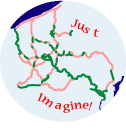|
|
||||||||
 |
Linking Up |

|
||||||
|
| ||||||||
Good trips usually have someone working behind the scenes to be sure all the important arrangements are taken care of. That means, for example, knowing where you’ll stay at night (or at least where the campsites are), but it does not mean knowing exactly where you’ll have lunch every day or exactly what time you’ll get off the trail. Here’s a checklist of the major things to plan in advance.
The Four Big Decisions: Start by deciding how much luxury you want to pay for, how much support you want, what distance you’ll ride each day, and which direction you’ll travel. The decisions are described on here.
Participants: You may start by knowing who’s going, then make a plan to accommodate that group. Or you may make the plan first and then fill the trip. As the number of people increases, you need more careful planning and organization, and a group of more than 10-15 people can be unwieldy. If you plan to camp at the Hiker-Bikers along the C&O Canal, you should limit your trip size to 4 small tents or 6 people, as most of the sites are small and you might be sharing your site with several other parties.
Itinerary: Your Big Decisions on daily distance and direction to travel set the preliminary itinerary. After choosing distance and direction, your Big Decision on luxury determines which overnight stops can handle the number of people in your party. Unless the trip is fully supported, your choices will be limited because lodging must be within biking distance of the trail (camping, indoor lodging). In any case, we think biking to the overnight stop preserves the continuity of the trail experience. Make a preliminary itinerary and revise until you like the distances and locations. Use the sample itineraries, the lodging list, and the mileage chart to help. Remember to allow for the distance to lodging and meals. If you don’t have enough days for the whole trip with your preferred daily distance and the available lodging, decide which part of the trip to ride and which part to save for another time.
Lodging: If you’re planning to stay at hotels, motels, B&Bs, or hostels, make reservations in advance (list of places). For lodging in smaller towns, reserve far in advance. Camping is more relaxed: C&O hiker-biker campsites are officially first-come-first-served, but they’re shared in practice, so you won’t need reservations (campgrounds). Decide whether the trip leader will make all the reservations or distribute a hotel list for trippers to make their own.
Meals: Most towns with lodging have restaurants; the ATA web site at https://gaptrail.org/ has current information. Lunch is not a problem, as you’ll probably pass a town with groceries or prepared food every day. The grocery stores are often just convenience stores, so consider carrying an extra day’s lunch. If you’re camping, decide whether you’ll cook as a group or individually; for group cooking decide who cooks when – and who cleans up.
Support: Your Big Decision on support determines how many vehicles and drivers you need. If you’ll be riding completely self-contained, or if you’re hiring an outfitter for full support, you don’t have to worry about this. Otherwise, decide how many support vehicles you’ll need and who will drive them. If you’re lightly supported, you simply have to carry the baggage from one night’s lodging to the next; you won’t need to carry all the bikes and bikers. For this, one minivan is probably plenty for 6-8 people. If you chose full support, you need enough car, van, or trailer capacity to drive people and bikes from the trail to lodging several miles from the trail. Suggestions about these logistics are here. All your vehicles need drivers; be certain they’re insured. You can find someone to drive every day, or you can share driving among the people on the trip
Transportation to and from the trail: Figure out how to get all your people, baggage, and bikes to the trailhead where you will begin your trip and how to get them home from the trailhead where you will end the trip. Advice on getting to and from the trail is here. If you leave cars at your starting trailhead, you'll need a way to get cars and people reunited. Usually this means either getting someone to drive the cars to the end or getting someone to drive the people back to the beginning. Outfitters may be able to help move people or cars.
Detours around trail gaps: The trail is almost complete from McKeesport to Washington. The possible detours are discussed here.
Bicycles: People usually prefer to ride their own bikes. If you need to rent bikes, try the bike shops listed as offering rentals. Much of the C&O Canal Towpath is too soft or too rough for a road bike with skinny tires, but you don’t need all the tread of a true mountain bike tire. We recommend a hybrid or touring bike with slightly knobby hybrid tires or else a mountain bike with conservative tires, for example semi-slick tires (smooth in the center of the tread for pavement, and knobby on the edge of the tread for mud or loose sand. Be sure the riders are comfortable on the bikes, especially the seats. Be sure all the bikes are in good mechanical condition. Children are required by law to wear helmets. All bike riders should wear helmets, and laws in some areas require helmets and bells.
Sharing expenses: There’s no single best way to handle expenses. Pick one in advance, make sure everyone understands it, and keep adequate records.[ Linking Up Home ] [ FreeWheeling Easy Home ] [ Shaw-Weil Home ]